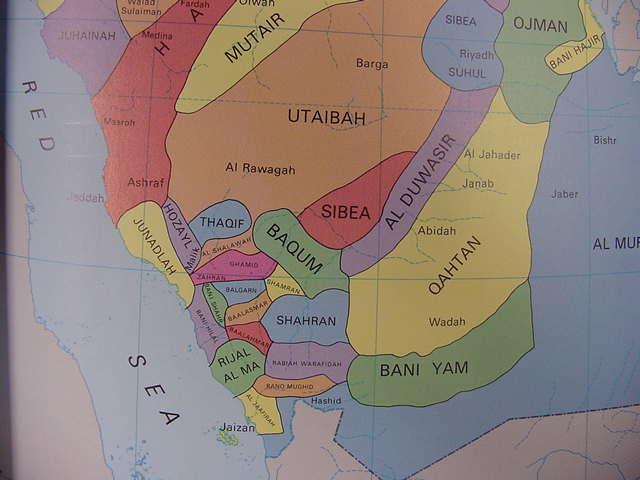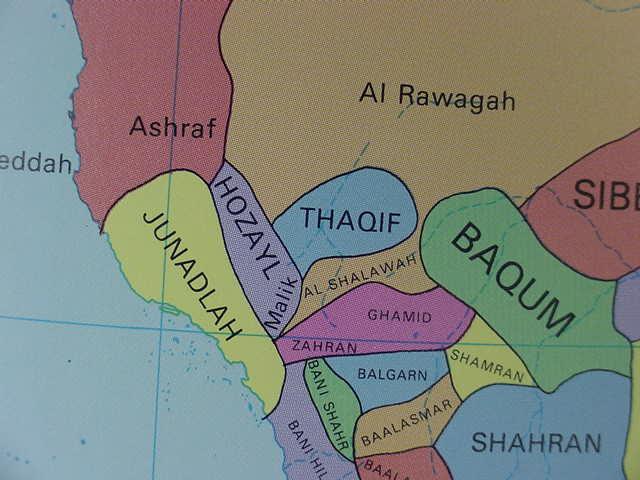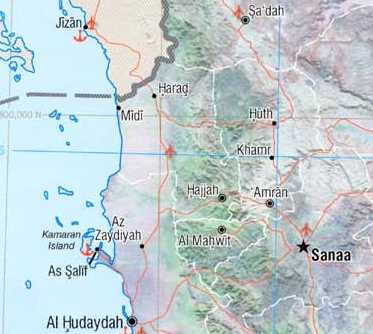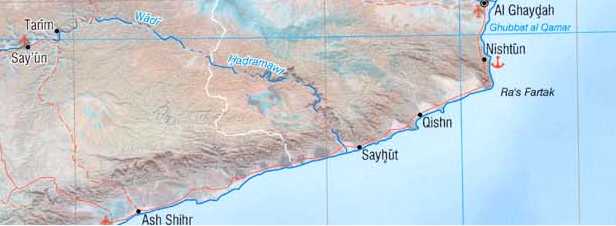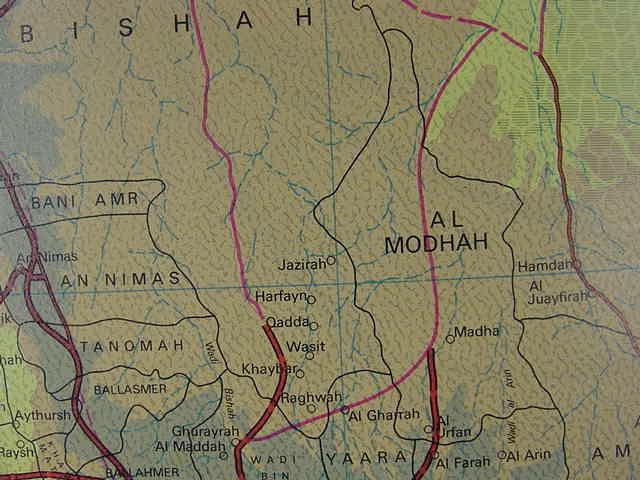Joktan's Descendants (Genesis 10:25-30): Almodad, Sheleph, Hazarmaveth, Jerah, Hadoram, Uzal, Diklah, Obal, Abimael, Sheba, Ophir, Havilah, Jobab, dwelling between Mesha to Sephar a mountain of the east.
27 September 2009 (Revisions through 04 October 2009)
Genesis' so called Table of Nations lists Joktan and his descendants. What follows are suggestions for the locations of these various Arab Tribes.
Shem, father of Peleg and Joktan might be preserved in Ash Sham a mountainous region facing the Red Sea, SW of Qalat Bishah and NW of Abha.
Joktan might be preserved in the modern tribal federation called Kahtan located in present day Saudi Arabia.
The below tribal map is reproduced from Hussein Hamza Bindagji. Atlas of Saudi Arabia. The below map is tited: "Tribes." Oxford, England. Oxford University Press. 1980. Note: this is a paperback book without any page numbers.
Uzal might be preserved in the modern tribal confederation Hozayl on the below 1980 map (Hussein Hamza Bindagji. Atlas of Saudi Arabia. The below map is tited: "Tribes." Oxford, England. Oxford University Press. 1980. Note: this is a paperback phamphlet of 72 pages but without any page numbers). Mueller (1992) noted that some claim the capital of Yemen, San'a was once called 'Azal and identify the name with this location and that Glaser (1890:434) proposed an Uzal in the region of Yathrib/Madina in the eastern Hijaz (cf. W.W. Mueller. "Uzal." pp. 775-776. Vol. 6. David Noel Freedman. Editor. The Anchor Bible Dictionary. New York. Doubleday. 1992).
Sheleph according to Muller (1992) might be the South Arabian Yemenite tribe as-Salif or as-Sulaf (Mueller also notes other proposals not covered in my below transcript from his article):
"A son of Joktan...Arab geographers refer to a Yemenite tribe bearing the name as-Salif or as-Sulaf. Al-Hamadi (1884: 100.7) mentions as-Salif bin Zur'a, which form a branch of al-Kala and which resided in the Mihlaf as-Sahul in the region of present-day Ibb, wher a place name al-Aslaf (plural of Salif) bears evidence to them...Together with the tribes of Akk and al-As'ar in the Yemenite coastal plain, the Sulaf are said to have venerated the idol al-Muntabiq...Those as-Salif (or as-Suluf or as-Sulaf respectively) are most probably to be identified with the slfn mentioned in the Late Sabaean inscription CIH 621.5, where they are listed among tribal groups which participated in the construction of the stronghold of Mawiyat, the present-day Husn al-Ghurab near the ancient harbor of Qana, where the inscription was found..."
(W.W. Mueller. "Sheleph." p. 1192. Vol. 5. David Noel Freedman. Editor. The Anchor Bible Dictionary. New York. Doubleday. 1992) I note that today the name seems to survive at the Yemeni port of as-Salif north of Al Hudaydah, cf. below:
Hazarmaveth has long been identified with the vicinity of Wadi Hadramawt in the Yemen on the below map.
Mesha might be Khamis Mushayat in the mountains of Asir Province of Saudi Arabia, near the border of the Yemen. Some suggest Mesha is futher north. I favor a SW Arabia location as many of Joktan's descendants seem to clustered in this area.
Sephar, "a mountain of the east" might be modern Oman which possesses a low mountainous area (rather like the hill country extending from Hebron to Beersheba in the Negev) rendered alternately Zufar or Dhofar on various maps.
Miles (1919) on Sephar being Dhofar:
"The name and description of Dhofar, which lies to the east of Hadramaut, coincides with those of Sephar as given in the Bible...The Alexandrian Codex in the British Museum is said to give the name more correctly as Sopher, being thus more in accord with the Arabic Dhofar."
(p. 498. Samuel Barrett Miles. The Countries and Tribes of the Persian Gulf. 1919)
That is to say Mesha and Sephar may be mountainous areas marking off the boundaries of the Yemen and some of Joktan's descendants from west (Mesha/Mushayat) to east (Dhofar/Zuphar)?
I have _not_ consulted the following work which would probably be very useful to anyone seeking to identify biblical Joktan and his sons:
I have _not_ consulted the following work which would probably be very useful to anyone seeking to identify biblical Joktan and his sons:
Richard Trench. Gazetteer of Arabian Tribes. 18 Volumes. Cambridge Archives Series. Cambridge, United Kingdom. 1996. With 6 maps showing various tribes and clans. It sells for 5,000 British Pounds Sterling (USA $10,000.00).
Book Description: Archive Editions Ltd (Cambridge University Press), 1996. Hardback. Book Condition: Brand New Hardback. 17.64 by 17.6 inches. (12,000 pages). The Gazetteer provides a magnificent collection of historical descriptions of Arabian tribes from British archival sources in the 19th and 20th centuries. Some 745 tribes are included, representing most of the major clans and families in the Arabian peninsula. From Iraq and Syria the geographic coverage includes Jordan, Saudi Arabia and the Gulf States to Oman, the Hadhramaut and Yemen. The records show territories and nomadic routes, tribal relations and allegiance, military strength, personalities and modern influence. These volumes provide the broadest array ever assembled of English language historical references concerning approximately 745 tribes, tribal confederations and clans in the Arabian peninsula. It is likely to remain the definitive research work for tribal history. From the eyewitness accounts of the Hijaz tribes riding into battle in 1917 to a social and political breakdown of the Jaburi tribe of Iraq, this gazetteer is an important resource to the study of Arab history.
Havilah might be the Haulan, Hawlan, Khaulan tribal federation which exists today in four areas, three in the Yemen and one in Saudi Arabia near the Yemen's northwestern border.
Ophir, famed for its gold might be the Jauf area of Yemen, NE of Sana where several gold workings (adits) have recently been discovered and documented? Of interest: A region called Al Hofair and a settlement of the same name, north of Hail, in the Saudi Arabian province of Hail (Hussein Hamza Bindagji. Atlas of Saudi Arabia. Oxford University Press. 1980). To the degree Solomon's ships sailed to Ophir for gold, this suggests Ophir is a region or port or tribe near either the Red Sea or Indian Ocean. The Afar are near the Red Sea coast of Africa opposite the Yemen.
A tribe called the Ifar exist near the Indian Ocean coast of the Yemen.
Sheba might be preserved in a town called Shabwah or the region called Ramlat As Sabatayn, both are to the east of Marib in the Yemen and the Sabaeans of Classical texts.
Jobab, Hebrew: yobab, according to Muller (1992) is attested as a tribal name in Sabaean records:
"The last of the thirteen sons of Joktan...The Sabaean tribe with a similar name (yhybb) was one of the three old tribal federations of the ancient country of Sum'ay in the central highland of Yemen. This tribe or its tribal leaders are mentioned in several inscriptions from the same region...The text of RES 4176 was engraved into a large rock near the mountain of Riyam in Arhab during the first quarter of the 3d century BC and contains the statute of the god Ta'lab for his worshippers from Sum'ay. In these regulations it was ordained that the leader of the tribe Yuhaybab was placed in charge of the property of the god and that he had to organize a banquet for the pilgrims during the annual pilgrimage to the sanctuary of Ta'lab."
(W.W. Mueller. "Jobab." p. 871. Vol. 3. David Noel Freedman. Editor. The Anchor Bible Dictionary. New York. Doubleday. 1992)
Almodad might be preserved in the prefecture of Al-Modhah in the Saudi Arabian province of Asir, just SE of the prefecture of Bishah (H. H. Bindagji. Atlas of Saudi Arabia. Oxford. 1980).
Jerah (Hebrew: Yerah) might be preserved on the below map as the prefecture of Yaara, south of Al Modhah.
Hadoram (Gen 10:27) might be the inhabitants of the villages near Wadi Hadramawt as they are collectively referred to locally as the Hadharem, "the people of Hadramawt." Perhaps they are the Adramites of Ptolemy and Pliny?
"In the olden days - Hadhramout's importance came mainly from it having been a very important route of the incense trade, which made it prosperous and strong. The Hadharem, as the people of Hadhramout are called, love traveling and adventures. Historically, few Arabs have traveled as extensively as Hadhramys have; and fewer have left their marks in other parts of the World, as the people of Hadhramout have done."
Obal "Glaser (1890:427) considered whether 'obal is to be identified with Yemenite 'Ubal, a locality on the Wadi Siham between Bagil and Hagailah at the border of the Tihamah toward the highland; if this is correct, one would have to look for 'obal in the middle of the Yemenite coastal plain. At the same time, however, Glaser drew attention to the fact that a form like 'Abil or 'Aibal would better correspond to the biblical name. A clan or tribal group (bnw) 'blm is attested several times in the Sabaean inscriptions, especially in votive texts from Marib."
(W.W. Mueller. "Obal." pp. 4-5. Vol. 5. David Noel Freedman. Editor. The Anchor Bible Dictionary. New York. Doubleday. 1992)
Abimael might be
Jerah (Hebrew: ye'rach) has been identified with a fortress called Jerach SW of the town of Damar.
